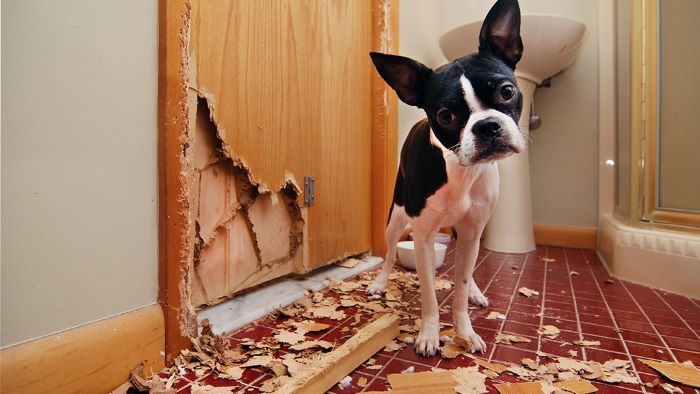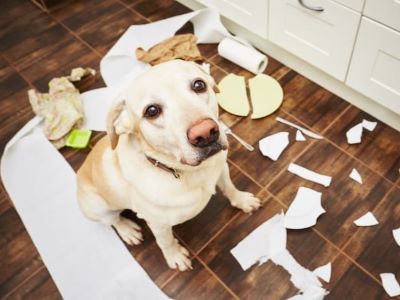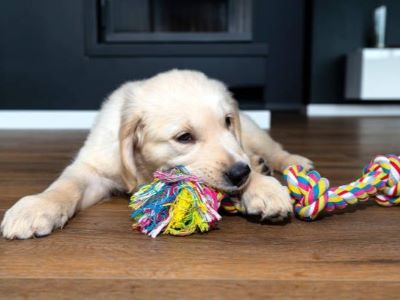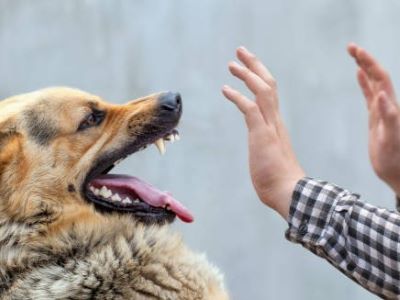Every dog owner faces this common problem sometime in their life. You arrive home to find your dog has gnawed the cushions yet again. Dog chewing may seem like an incurable habit but with insights into causes and strategic training, it can be stopped. So, how to stop dog chewing furniture exactly?
In this article, we’ll deep dive into why dogs chew furniture in the first place. Understanding the roots of the behaviour is key to changing it from the basics. You’ll know about the techniques to curb chewing, from puppy-proofing your home to providing appropriate outlets for your dog’s needs.
Know how to actively reinforce good chewing behaviour while using obstacles to make furniture unappealing. We’ll also highlight common pet-parent mistakes that can unintentionally encourage furniture gnawing.

Why Dogs Chew Furniture?
It is important to understand what motivates this destructive behaviour before you try to stop them chewing household objects. There are several common underlying reasons why dogs can’t control themselves sinking their teeth into your furniture. Here are a few reasons why[1]:

Teething Puppies:
For puppies, chewing serves the natural functions of easing sore gums during teething and allowing exploration of their environment. Those sharp puppy teeth apply a lot of pressure to tender gums as they erupt.
Gnawing on furniture and other items around the house brings relief. Puppies also use their mouths to investigate objects as they learn about the world around them.
Boredom and Excess Energy:
Dogs that are left alone for extended periods without stimulation or activity tend to find unhealthy chewing outlets. Dogs with pent-up energy from lack of exercise may also chew items like furniture out of boredom and a need for an activity. They have no other way to expend all that unused energy. This causes them to nibble their nearest furniture.
Stress and Anxiety:

Changes in routine, a new home, separation anxiety, loud noises, or other environmental factors can cause dogs to feel anxious. Nervous chewing of household objects provides stress relief for dogs lacking other calming outlets. Specific triggers may prompt it to chew.
Medical Issues:
Lastly, health issues like dental pain, gastrointestinal issues, skin irritation, and joint pain can also provoke furniture chewing as a way for dogs to seek relief from discomfort. The act of gnawing brings temporary distraction.
Tips to Stop Furniture Chewing
If you want your dog to stop chewing your furniture, you need to identify what is motivating it. Once, you’ve identified that, you can take steps to prevent that behaviour from happening again. You can try implementing your solutions as follows[2]:
Puppy-Proofing Your Home:

For puppies and dogs that chew due to teething or curiosity, it is essential to minimize access to tempting objects. Keep dogs confined to rooms like crates or gated kitchens when you are away or unable to supervise.
Remove shoes, furniture, carpeting, and electrical cords from their reach. Provide a wide range of appropriate chew toys made of nylon, rubber, or rope that will soothe sore gums and satisfy the need to gnaw. To keep your dogs interested and engaged for a longer period, you can rotate their toys.
As your puppy’s adult teeth come in around 6-7 months old, upgrade to more durable chew toys designed for their stronger jaws.
Ensuring Adequate Exercise and Activity:
Dogs that chew furniture out of boredom and pent-up energy need sufficient daily physical activity tailored to their age, breed, and fitness level. Taking high-energy dogs for long walks and runs helps release endorphins and tires them out.

Interactive playtime with toys that encourage chasing and retrieving also prevents your dog from seeking destructive outlets on your belongings. Providing opportunities to socialize and play with other dogs at a park or daycare provides mental stimulation as well.
Providing Mental Stimulation:
Incorporating mental stimulation into a dog’s routine is equally as tiring as physical activity. Set aside time for obedience training sessions, introducing new tricks, or completing interactive food puzzle toys. Playing hide-and-seek by hiding treats around a room and having your dog search for them engages their mind.
Introducing new toys, objects, and environments frequently prevents boredom. Consider minigames and food-releasing toys that force dogs to problem-solve. A mind drained of energy is less likely to target your furniture.
Give Your Dog Attention:
Make sure your dog gets sufficient one-on-one quality time with you. Set aside portions of your day focused entirely on them through cuddling, relaxed play, or just being present together. Don’t mistake reinforcing furniture chewing by giving your dog attention only when they exhibit bad behaviour.
Also, make sure you are fulfilling their social needs – dogs are pack animals that can become destructive if deprived of companionship.
Using Obstacles:
A variety of taste and texture barriers are available to discourage furniture chewing. Bitter apple sprays applied to furnishings create an unpleasant taste when gnawed. Double-sided sticky tape also attaches to your dog’s muzzle unpleasantly.
Aluminium foil or plastic carpet runners placed on surfaces feel uncomfortable. Remote-activated alarms or shaking cans filled with coins, rocks or buttons when chewing occurs also startle dogs. Be present to issue these obstructions for maximum effectiveness.
Reinforcing Good Behaviour:
Whenever you catch your dog chewing on an acceptable toy, offer enthusiastic praise and provide a tempting reward like a treat or belly rub to reinforce the behaviour. Ignore unwanted chewing behaviours – even negative attention can reinforce the habit. With patience and consistency, your dog will learn furniture is off limits but their toys offer rewarding chewing fun.
What Not to Do?

It’s important not to use certain ineffective or harmful disciplinary tactics when trying to stop furniture chewing. They often inadvertently encourage your dog to the undesirable behaviour:
- Punishing After the Act– Yelling or scolding a dog after catching it in the act does not address the motivations behind the chewing. From the dog’s perspective they are being punished for the owner’s presence, not the chewing. This can seed anxiety.
- Relying on Physical Punishment – Hitting a dog, rubbing their nose in the damage, or other forms of physical discipline are inhumane and send confusing messages about how to interact with a dog’s mouth. This can increase the risk of biting.
- Giving Up Too Quickly – Overcoming inappropriate chewing takes time, consistency, and patience. Not seeing immediate results is expected. But prematurely giving up risks reinforcing the bad habit. Stick to your training plan.
- Reacting Emotionally – Dogs can perceive the owner’s strong emotional response to damaged objects as rewarding attention. Remain calm and lighthearted, then quietly remove access to the tempting item.
- Allowing Access When Alone – If dogs associate chewing with the “reward” of the owner returning home, it encourages the behaviour. Crate training or confinement prevents access when alone.
FAQs
Why does my dog chew furniture?
Common reasons include teething/boredom in puppies, excess energy in adults, separation anxiety, and medical issues causing discomfort. Chewing provides an outlet.
How to Stop Dog-Chewing Furniture?
Puppy-proof your home by removing access to tempting furniture. Provide appropriate chew toys instead. Confine them when unsupervised. Make sure they get plenty of exercise and stimulation.
My adult dog suddenly started chewing furniture – why?
Sudden destruction chewing in adult dogs often indicates an underlying medical issue like dental pain or stress/anxiety. Schedule a vet visit to identify the cause.
What are effective ways to stop furniture chewing?
Use deterrent sprays/tapes to make furniture unappealing. Reward them for chewing proper toys. Ensure they get adequate exercise, training, and attention. Maintain a predictable routine.
How do I punish my dog for chewing furniture?
Don’t punish after the fact. It’s ineffective and risks Making anxiety worse. Prevent access, reinforce alternatives, and address underlying causes positively.
Conclusion
Furniture chewing is an annoying issue that most dog owners will encounter at some point. While frustrating, it’s important to avoid ineffective punishments that can make the problem worse. Instead, focus on fulfilling your dog’s needs in positive ways.
With a combination of puppy-proofing your home, ensuring adequate exercise and enrichment, managing stress, using distractions, and reinforcing good behaviour, furniture chewing can be overcome. Be patient – it may take weeks or months to see lasting improvement.
The key is addressing the root motivations behind your dog’s urge to chew. Providing appropriate outlets and preventing access to temptation remains far more effective than disciplining after the fact. With consistency and persistence, you can curb destructive chewing for good. This is how to stop dog chewing furniture.
References:
- Why Does My Dog Chew My Furniture and Baseboards? | Americal Kennel Club
- Destructive Chewing | ASPCA



